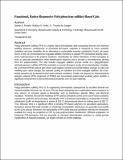Functional, Redox-Responsive Poly(phenylene sulfide)-Based Gels
Author(s)
Romero, Nathan A.; Parker, Wallace O.; Swager, Timothy M
DownloadAccepted version (1.326Mb)
Publisher Policy
Publisher Policy
Article is made available in accordance with the publisher's policy and may be subject to US copyright law. Please refer to the publisher's site for terms of use.
Terms of use
Metadata
Show full item recordAbstract
Poly(p-phenylene sulfide) (PPS) is a highly robust thermoplastic with outstanding thermal and chemical stability. However, development of functional PPS-based materials is hampered by harsh synthetic conditions and poor solubility. As an alternative to nucleophilic aromatic substitution (SNAr), we report herein on the use of benzoquinone conjugate addition chemistry to prepare PPS derivatives bearing redox-active hydroquinones in the polymer backbone. Specifically, we utilize thiosilanes as thiol surrogates to attenuate unproductive redox isomerization reactions and to provide a thermodynamic driving force for polymerization. The silyl transfer conjugate addition process results in a poly(phenylene silylhydroquinone sulfide) (PPSHS) amenable to several divergent modes of functionalization. Notably, the so-formed PPSHS exists as gels, which swell organic solvents and exhibit distinct changes in color and swelling upon redox changes. By repeated cycling of oxidation and thiol conjugate addition, the cross-linked networks can be depolymerized under ambient conditions. Finally, we prepared an interpenetrating polymer network (IPN) composed of PPSHS and cross-linked poly(n-butyl acrylate), which exhibits a significant enhancement in thermomechanical properties over the base materials.
Date issued
2019-10Department
Massachusetts Institute of Technology. Department of ChemistryJournal
Macromolecules
Publisher
American Chemical Society (ACS)
Citation
Romero, Nathan A. et al. "Functional, Redox-Responsive Poly(phenylene sulfide)-Based Gels." Macromolecules 52, 21 (October 2019): 8256–8265 © 2019 American Chemical Society
Version: Author's final manuscript
ISSN
0024-9297
1520-5835